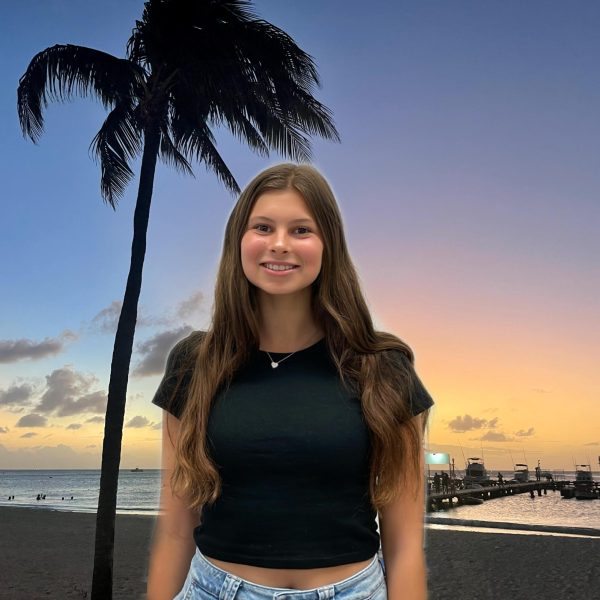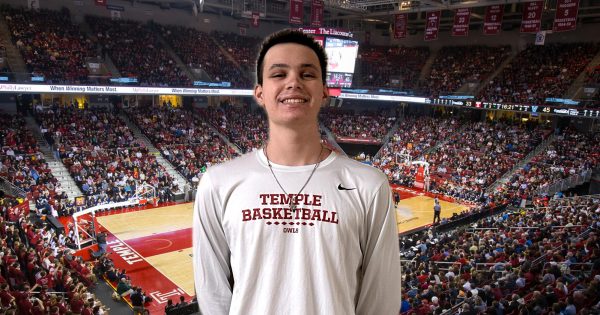Jon Baeckstrom (‘08), a Cherry Hill High School East alum and past entertainment editor of Eastside, spoke with Eastside sports editors about his experience writing for the World Wrestling Entertainment (WWE) Monday Night Raw. This interview has been edited for length and clarity, but it can be seen in its entirety online via the QR code on this page.
HL: We wanted to start by asking you to introduce yourself and explain to the people watching what your profession is.
JB: I’m currently the lead writer for Monday Night Raw, which is one of the two flagship shows for… we call it sports entertainment. I’ve been with the company for about ten years on the writing staff and creative department, generating the storylines for the television shows that drive the company.
HL: You mentioned that you attended Cherry Hill East. What was it like growing up in the area attending East and being on the Eastside board?
JB: It was great. My family still lives there. For Eastside, I remember doing a couple interviews, writing a couple of articles, and then taking journalism my [junior] year. It’s funny, I don’t remember a ton of high school, but I still remember a lot of Eastside and a lot of that journalism class. I even remember my final project was making my own newspaper and I made mine on WWE actually. I had no idea back then that I would end up working there.
HL: Getting into what you do now, how did you get started and find your way into the company? As you worked your way up, what lessons have you taken away from that?
JB: After college [at the University of Notre Dame], I was trying to get a job as a writer assistant, which is like the entry-level position for those aspiring to write in the entertainment industry. It was really lucky timing that WWE happened to be hiring for writer assistants at the time, so I started there in summer 2013. There’s so much work that needs to be done at WWE that trust was built just by showing up every day and doing my job. If they could trust me to make coffee the right way, print out the right documents and hand them out to the right people, then they could start trusting me to sit in on creative meetings and take notes. Then it just grew from there. One of the main things I’ve learned is that everything takes time, especially having been on the other side of things and helping bring new people in. I appreciate how much of it is baby steps like showing up, doing your best every day.
HL: What is the process that goes into writing WWE TV weekly?
JB: It’s a seven-day a week, 365-day type of deal. We don’t have an off-season, so every day we’re pretty much always in a state of trying to figure out what we want to pitch for the show. My co-lead writer, Ryan Ward, and I will be working with our team to come
up with ideas for the show and have our creative meeting with the Head of Creative, Triple H [Paul] Levesque, once or twice a week. We discuss everything from big picture stuff—
WrestleMania, months – long story lines, those types of things— to the day-to-day specifics of the show. Once we have a plan, we begin the writing process, another big collaborative effort, to turn out a three-hour TV show each week. On the day of TV, which for us is Mondays, we travel to the week’s city and arena. We’ll work to put the show on live with Paul that night, and everyone from the company is involved: the cameraman, the director, the talent, the writers.
JS: Do you have any breaks during the year? What are the hours like?
JB: Luckily, it’s not every single day, like we’re not working Christmas, which is nice. But short of that, there’s usually something that would come up, even if it’s a few text messages or an email. WWE is a machine that never stops turning, and some weeks all sorts of things can happen. We may be producing an additional show; we have our pay-per-views, so that’s extra work. I’ve done some 20-plus-hour days, but it’s part of the job. You have to roll with the punches because this show is different every week.
HL: What are some of the matches that you’ve gotten to be a part of, or seen, that have been really special?
JB: Sure, I don’t get involved in the matches, I’m a writer, and as I like to remind people at work, I’m just a nerd with the keyboard. As far as the matches, when I first started, WrestleMania 30 in New Orleans had two kinds of the most memorable matches in very short succession. You had the end of the Undertaker, one of our most iconic characters. He had been undefeated in WrestleMania for like 25 years, 21-0, and he lost his first match there. In the Superdome filled with 70 to 80 thousand people, you could hear a pin drop—it was so shocking. Then, later that night, you had Daniel Bryan win in the main event and that is maybe the most excited I’ve ever seen a crowd. Seeing the swing of emotions for people within the span of like an hour, it set the tone for like, “OK, this is what this place is all about for me.” It’s the storytelling, it’s drama.
HL: What does it mean to have an event such as Wrestlemania come so close back to where you grew up?
JB: I’ll be honest, I’m really excited. I’ve done 500 or 600 episodes of Raw, another few hundred Smack Downs, 150 pay-per-views, maybe 200 at this point. So I’ve seen a lot, but seeing WrestleMania take place at Lincoln Financial Field and doing Raw the next night at Wells Fargo, it means a lot to me personally, especially because my family is from the area.
HL: What goes into planning and writing for an event so big such as WrestleMania?
JB: It’s a huge operation. There’s a whole production team, and I can’t do justice to how talented
these people are. There’s a lot that goes into it: the set design, the pyro, the sound system, the seating design, ticket sales, advertising. It’s a multiyear operation in terms of setting up these shows. We’re always thinking about WrestleMania from a creative standpoint and then we’re entering the time of year where it’s going to become a bit all-consuming. It’s what I was alluding to earlier about the hours. As we get close to WrestleMania, you work as long as you got to work to make sure that the show goes off without a hitch, because those are the shows we get remembered by.
JS: Has female viewership changed over time with the WWE?
JB: I’m not 100% sure where the demographics stand, it’s been a while since I got an analytics breakdown of that because we do get analytics that help us break down how we’re doing in terms of viewership. One of the things that’s been really cool and it’s been well documented and better explained than I can probably do justice to, but there’s been this change in the company that I’ve been able to witness, it’s been referred to as the woman’s evolution, where the female performers were a sort of small part of the show back in the day and they were presented differently, and for a variety of reasons one of the big ones being just the quality of the performers who have come in, people that again, names like Charlotte Flair and Becky Lynch, who come in and [are so] talented as character performers, but also the in ring athleticism has changed everything. I’ve seen the first women’s match at main event at RAW was back in 2004, but I’ve had the privilege of being here to witness the main event, the first pay-per-views, and even the first WrestleMania in 2019 when Becky Lynch had a main event at WrestleMania with Charlotte Flair and Ronda Rousey, so it’s been a really cool improvement in the overall product that I’ve had a chance to witness and observe up close thanks to some really talented people who have worked really hard at it for a long time.
JS: What would you say is your favorite part of your job?
JB: My favorite part of the job is the moments where we look at each other and go “I get paid for this.” We did a segment on the show, maybe six years ago roughly, where three of our characters literally got into a refrigerator box that we had decorated as a time machine and we presented it like they had gone into the past and switched the cameras over to black-and-white. It was one of the dumbest, funniest things I’ve ever seen. It’s those little moments that I’m gonna carry with me twenty to thirty years from now and look back, and think, “Wow, I got to show up at work one day and tell grown men, ‘You are gonna get into the tiny machine refrigerator box. It’s gonna be great.’” They’re the big ones, [There is] WrestleMania, but it’s also a lot of those little moments of flavor that make the job really special.



